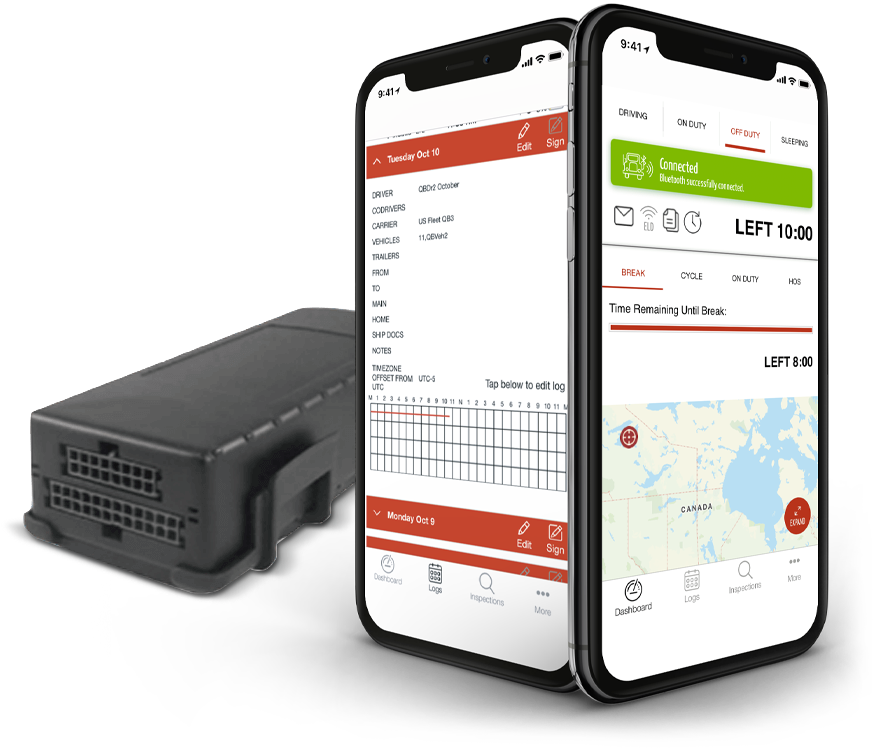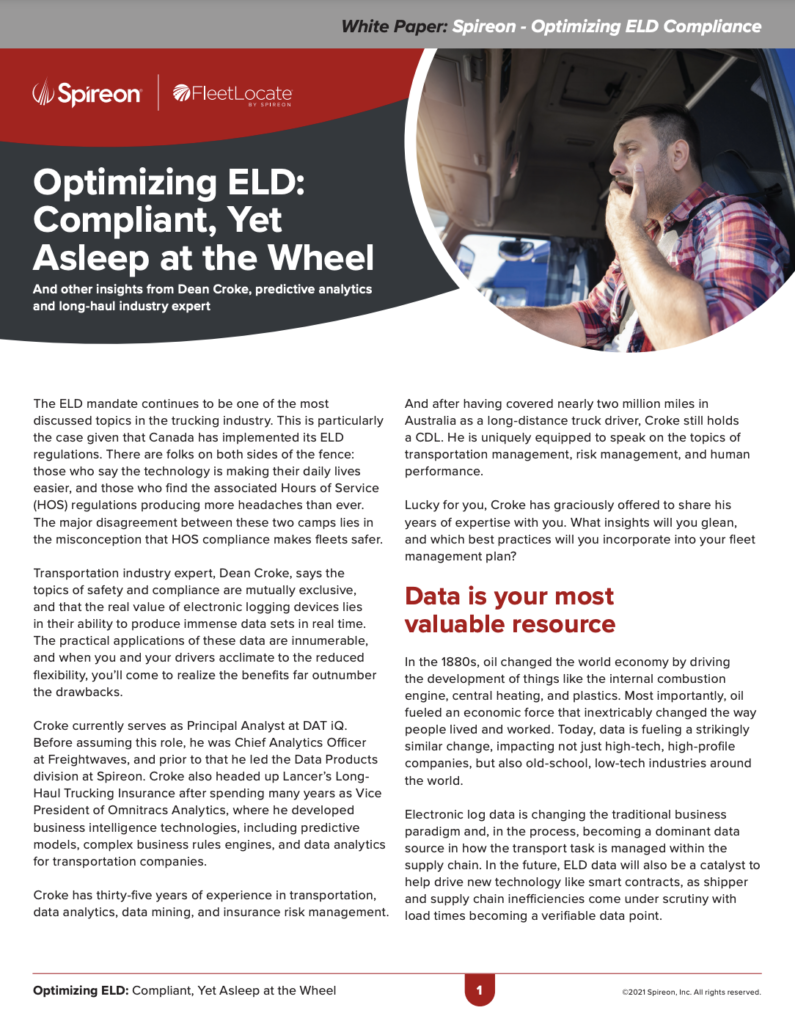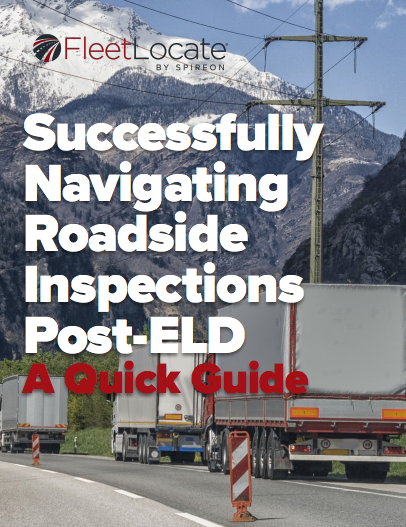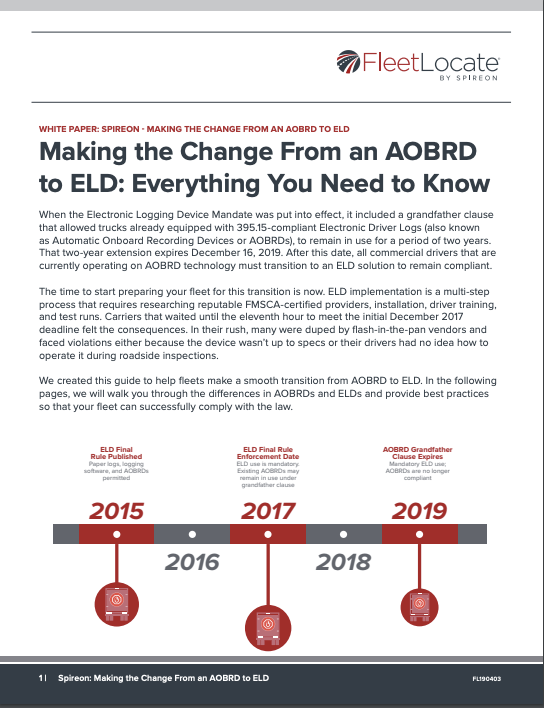ELD Mandate Resources
Will Your ELD Provider Be There For You? Make Sure You Have the Right ELD and Provider
As the shakeout of ELD providers begins, make sure you’re not left out in the cold. Make compliance with Federal Motor Carrier Safety Administration’s (FMCSA) electronic logging device (ELD), Hours of Service (HOS), and Driver Vehicle Inspection Reporting (DVIR) effortless via smartphone, tablet, or rugged handheld device with FleetLocate Compliance.
FMCSA Announces Hours of Service Rule Changes
On May 14, 2020, FMCSA released a “final rule” making four significant changes to its Hours of Service (HOS) rules in Part 395 of the Federal Motor Carrier Safety Regulations. Want to know what this means to you?
Find out in this quick overview from Scopelitis Transportation Consulting, which covers:
- 30 Minute Rest Break
- CMV Short-haul Exemption
- Adverse Driving Conditions
- Split Sleeper Berth Rule
- And a handy chart that compares the old rule to the new rule and provides an impact report.
Don’t get caught in the confusion — get your copy now!
Personal Conveyance under ELD: Clearing the Confusion
Personal conveyance has long been a source of confusion for the industry because rules dictating appropriate use are vague. Compounding matters is law enforcement’s keen focus on personal conveyance as a possible source of hours of service fraud. How can you clarify what’s required? Find out in this quick overview from Scopelitis Transportation Consulting, which covers:
- Under what circumstances may a driver operate a commercial motor vehicle (CMV) as a personal conveyance?
- If a driver picks up the CMV from a repair facility once repairs are complete, would the driver be allowed to use personal conveyance to their residence from the repair shop?
- When can a movement of a CMV during an off-duty period be considered personal conveyance?
- And more
Don’t get caught in the confusion — get your copy now!
FMCSA ELD Compliance Audits: What Do You Need to Know?
Want to better understand how FMCSA and, in some cases state agency auditors/investigators, review and audit electronic logging device (ELD) records for driver hours of service (HOS)?
Get our latest report from Dave Osiecki of Scopelitis Transportation Consulting, which covers:
- What is a Compliance Audit?
- The elements of an ELD Records Compliance Audit
- Auditing for falsified ELD records
- What kind of ELD records and “back office” reports investigators will request
- And more
Make sure you and your team are ready for an ELD audit before it happens—get your free report now.
See FleetLocate Compliance ELD Solution in Action
See a new and improved FleetLocate that manages any combination of drivers, vehicles, and assets – and ensures compliance with federal regulations like:
- Hours of Service (HOS)
- Driver Vehicle Inspection Reporting (DVIR)
- And more
And it’s all within the same friendly, easy-to-use application fleets love. See why FleetLocate Compliance is the Electronic Logging Device (ELD) solution that’s the right fit for your fleet.
Watch this informative webinar to see firsthand how FleetLocate can help you manage each of these key areas.
I’m Interested in More Information
ELD Mandate Compliance Reports
FleetLocate Manages Your ELD/HOS Compliance

Request A Demo

Other Resources
- FMCSA Answers 11 Frequently Asked Questions About COVID-19 HOS Waiver—CDL Life
- Another ELD provider shuts down–FreightWaves
- FMCSA Expands Coronavirus Hours-of-Service Exemptions – HDT Truckinginfo
- Senate Hearing Shows HOS Fight Is a Long Way from Over—Fleet Owner
- How to Use ELD’s New Data Points to Your Advantage
- AOBRD Phaseout Under ELD Rule Could Pose Challenges for Fleets and Vendors, Experts Warn– Transport Topics
- A year of ELDs, and the fast-approaching AOBRD deadline– FreightWaves
- 4 Common ELD Mistakes Fleets Make (And One Big Tip to Help)– FleetOwner
- Hours of Service of Drivers of Commercial Motor Vehicles: Regulatory Guidance Concerning the Use of a Commercial Motor Vehicle for Personal Conveyance
- Hours of Service of Drivers of Commercial Motor Vehicles; Regulatory Guidance Concerning the Transportation of Agricultural Commodities
- Trucking Law: How to properly log a yard move
- TCA-AOBRD – ELD Migration Preparation – Common Tips to assist compliance with the ELD final rule.
- More ‘Regulating by FAQ’: If Your ELD Goes Down, Go to Paper, or … ELS, Anyone?
- ELD Mandate Enforcement – (FAQs)
- Eld Mandate 10 Things You Need To Know – TruckingInfo.com
- List of Registered ELD Manufacturers – FleetLocate – Spireon and Gorilla Safety
- Read the FMCSA ELD Mandate Final Rule
- Frequently Asked Questions (FAQs) – ELD Rule
- Who is exempt from the ELD rule?
- ELD Implementation Timeline

ELD Glossary
• ELD: As defined in 49 CFR 395.2, electronic logging device (ELD) is a device or technology that automatically records a driver’s driving time and facilitates the accurate recording of the driver’s hours of service (HOS).
• AOBRD: Carriers with automatic on-board recording devices (AOBRDs) installed prior to Dec. 18, 2017, can take advantage of the grandfathered AOBRDs clause. WARNING: Starting Dec. 16, 2019, these devices will no longer be acceptable.
• RODS: The driver’s record of duty status (RODS), also referred to as the driver log, is the document the driver uses to record his or her on-duty and off-duty time. • Roadside Inspections: Certified inspectors carry out these examinations of commercial motor vehicles and/or drivers to ensure compliance with regulations. They may be conducted a weigh stations, border checkpoints, or if a vehicle is pulled over by a law enforcement official.
• CSA: Compliance, Safety, Accountability (CSA) is the FMCSA program to monitor and enforce safety compliance.
• SMS: The Safety Measurement System (SMS) is the methodology used by the FMCSA to asses a carrier’s safety compliance and on-road performance. A company’s safety data appears online in its SMS database. The FMCSA updates the SMS once a month with data from roadside inspections, including driver and vehicle violations, crash reports, and investigation results. It uses this data to assign CSA scores and prioritize carriers for investigations.
• CSA-SMS Score: The CSA-SMS score is used by the FMCSA to identify unsafe motor carriers and prioritize enforcement based on carriers that pose the greatest safety risk. A carrier’s score is based on data from seven categories: Unsafe Driving, Crash Indicator, Hours-of-Service Compliance, Vehicle Maintenance, Controlled Substances/Alcohol, Hazardous Materials Compliance (HM), and Driver Fitness. The SMS assigns a percentile from 0 to 100 (the higher the percentile, the worse the performance).
• HOS: Hours of Service (HOS) regulations are implemented by the FMSCA to limit the working hours of anyone operating a commercial motor vehicle. These rules were designed to eliminate drowsiness in commercial motor vehicle (CMV) drivers that can lead to crashes.
• OOS Violation: An out-of-service (OOS) violation removes the driver and vehicle from the road and prohibits them from returning until the violation or the malfunction is corrected or fixed. Inspectors may assign OOS violations if the CMV is not equipped with an ELD or if a driver fails to transfer his/her required hours of service data to law enforcement officials.



